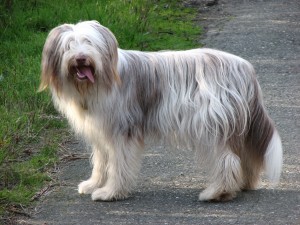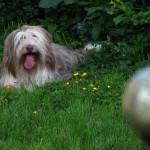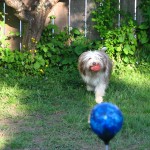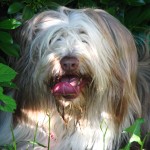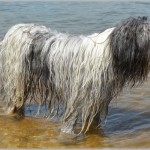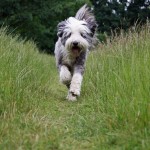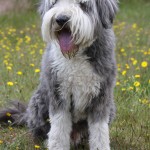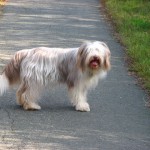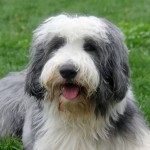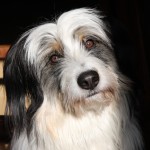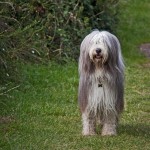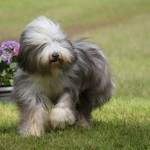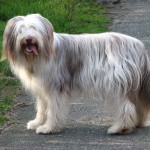Bearded Collie
"Beardie's intelligence makes them get bored quick during repetitive training."
Other names for this breed:Highland Collie, Mountain Collie, Hairy Mou'ed Collie
Breed nicknames:Beardie
Country of origin:Great Britain, Scotland
Traits:
Weight:45-55 pounds
Height:Male 21-22 inches, female 20-21 inches
Coat:Long double silky
Color:Black, blue, brown, fawn, can have white or tan markings
Litter size:4-12
Life span:12-14 years
Classification:
AKC - American Kennel Club: Herding
UKC - United Kennel Club: Herding
TKC - The Kennel Club: Pastoral
NZKC - New Zealand Kennel Club: Working
FCI - International: 1 - Sheepdogs and Cattle Dogs, 1.1 - Sheepdogs
With a name like bearded collie, you’d be forgiven for assuming that this dog breed is one of the miscellaneous mutts that have managed to get their paws on an actual beard. But no, the Bearded Collie is a well-established breed with its own rich history.
Bearded Collies are not only adorable and cuddly, they are also highly intelligent. They love nothing more than playing games with people and learning new tricks. They are great with children and have been known to become extra protective of them when there is any threat to the child’s safety. In addition, Bearded Collies make wonderful pets because they are relatively easy to train and very sociable as they get along well with other animals and people alike.
In this article, we will be exploring some interesting information about the Bearded Collie, including where it came from, what it looks like and how it behaves as a pet.
History and origin
The Bearded Collie, also known as the “Beardie,” is a breed of herding dog that originated in Scotland. Their origin can be traced back to the 16th century, when they were used by Scottish shepherds to herd sheep and cattle. They are believed to be a cross between the Scottish Highland Collie and the Hungarian Komondor.
The breed was named “Bearded Collie” due to their distinctive beard-like fur that covers their chin and cheeks. This breed was an important working dog in Scotland, where they were used to herd sheep and cattle in the hills and on the rough terrain. They were also used as droving (walking livestock over long distances) dogs, helping to move sheep and cattle to market.
By the end of the 19th century, the Bearded Collie was on the verge of extinction. However, a Scottish woman named G. Olive Willison started a breeding program to save the breed and successfully revived the breed’s popularity. These dogs were officially recognized as a breed by the Kennel Club (UK) in 1959, and by the American Kennel Club (AKC) in 1977.
Today, the Bearded Collie is a popular companion dog and show dog, as well as a talented herding dog. They are known for their friendly, playful, and intelligent personality, as well as their distinctive beard-like fur and shaggy coat.
Coat and grooming requirements
The Bearded Collie is well-known for its distinctive, shaggy coat that requires regular grooming to maintain its appearance. They have a long, thick, and shaggy double coat that is weather-resistant. The undercoat is soft and dense, while the outer coat is longer and coarser.
Coat can come in a variety of colors, including black, blue, brown, and fawn, as well as various shades of these colors. Some dogs also have white markings on their face, legs, chest, and tail.
The Bearded Collie’s coat requires regular grooming to keep it in good condition. This includes brushing their coat at least once a week to prevent mats and tangles, as well as bathing them as needed. It’s important to keep the hair around their ears trimmed to prevent infections.
This breed is a moderate shedder, but their coat can shed more heavily during certain times of the year. Brushing your Bearded Collie regularly can help minimize shedding and keep their coat in good condition.
Grooming your Bearded Collie is an important part of caring for your dog, and it helps to maintain their appearance and keep their coat in good condition. For grooming you will need a slicker brush, a comb, and a pair of scissors. A de-shedding tool can also be helpful in controlling shedding.
If you’re not comfortable grooming your dog yourself, consider taking them to a professional groomer for a regular trim.
Common health issues
The Bearded Collie is generally a healthy breed, but like all breeds, they can be prone to certain health problems. These include hip dysplasia, eye problems, bloat, allergies, hypothyroidism, and ear infections. Ear infections can be especially troublesome and common, as their floppy ears can easily trap moisture and bacteria.
Temperament and personality
Bearded Collies are known for their playful and energetic personality, which makes them great family dogs. They are playful and energetic, which makes them great playmates for kids. They typically get along well with other pets, including other dogs and cats. They may have a strong herding instinct, so it’s important to supervise them around small animals.
They are intelligent dogs that are eager to please and easy to train. They are quick learners and respond well to positive reinforcement training techniques.
Bearded Collies are known for their love and devotion to their owners and are often referred to as “velcro dogs” because they love to be close to their humans. They are affectionate dogs that enjoy spending time with their families.
Despite their affectionate nature, Bearded Collies can be independent dogs that like to do things their own way. They may be stubborn at times and require consistent and patient training.
Bearded Collies are active dogs that need plenty of exercise to keep them physically and mentally stimulated. They enjoy daily walks, runs, and play sessions, and they make great hiking or running companions.
Training tips
Bearded Collies are intelligent and eager to please dogs, making them relatively easy to train. Here are some tips for training your Bearded Collie:
- Positive reinforcement: Positive reinforcement training methods, such as treats, praise, and play, are the most effective way to train your Bearded Collie. Reward good behavior and ignore unwanted behavior to encourage your dog to make the right choices.
- Consistency: Consistency is key when it comes to training your Bearded Collie. Use the same commands and training techniques every time to help your dog understand what you expect of them.
- Socialization: Socialization is important for all dogs, and Bearded Collies are no exception. Introduce your dog to new people, places, and experiences from an early age to help them become well-adjusted and confident.
- Start early: It’s never too early to start training your Bearded Collie. Start training as soon as you bring your puppy home to help them learn basic commands and good behavior.
- Exercise: Exercise is an important part of training your Collie. Regular exercise will help keep your dog physically and mentally stimulated, which can make training sessions more productive.
- Patience: Be patient when training them. Remember that every dog learns at their own pace, and some may need more time and repetition than others.
- Professional training: Consider enrolling in a professional training class with your Bearded Collie. This can help you and your dog work on specific skills and behaviors and give you the opportunity to interact with other dogs and owners.
Training your Bearded Collie requires patience, consistency, and positive reinforcement. With these training tips and a little bit of effort, you can help your dog learn good behavior and become a well-trained and well-behaved companion.
Conclusion
In summary, the Bearded Collie is a friendly, playful, and intelligent breed that is well-suited to families and active individuals. With proper training and socialization, they make great pets and loyal companions.
Bearded Collie Photo Gallery
You can click on the gallery images below to view them full sized (most are in wallpaper resolution!).
























